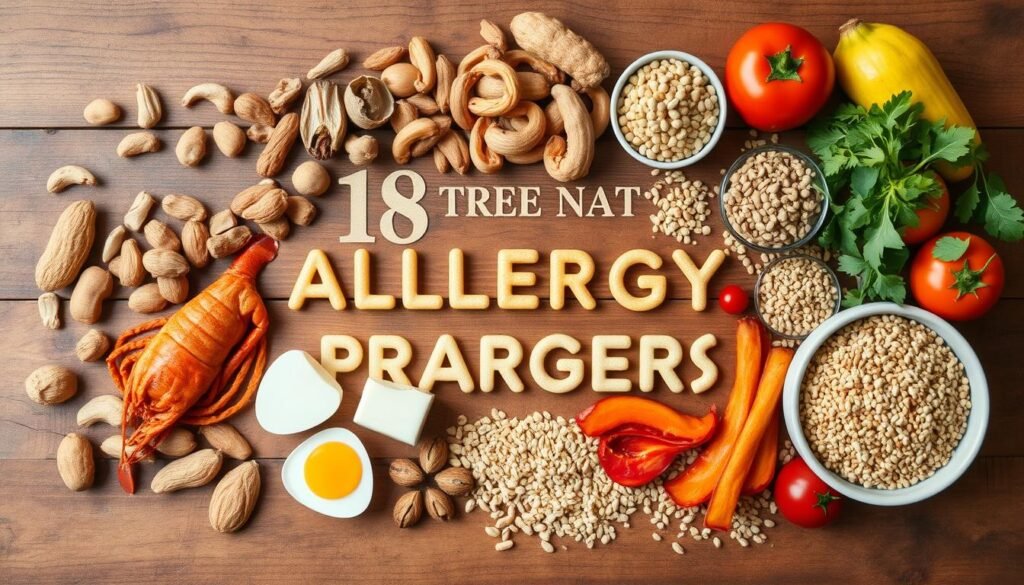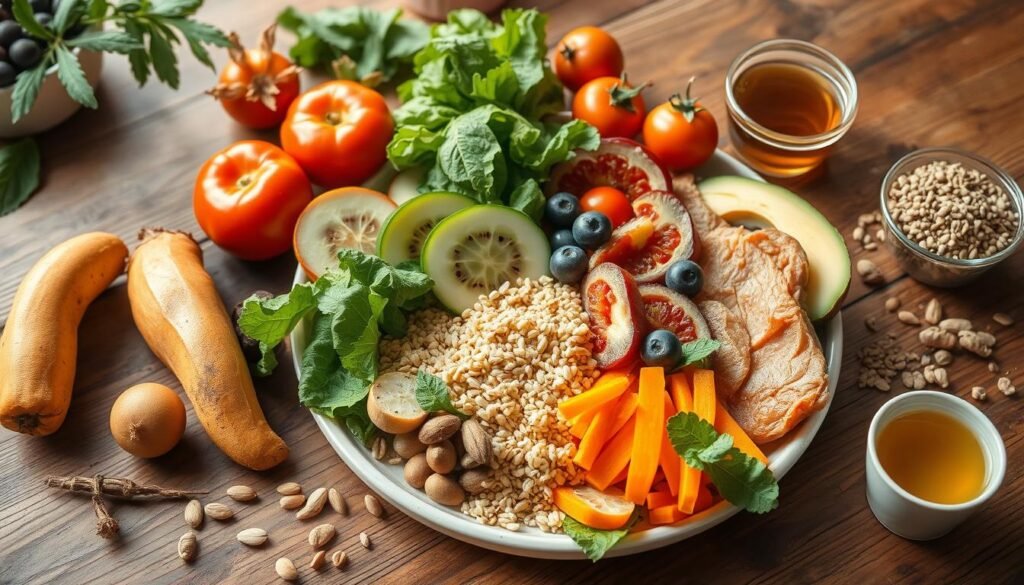Did you know that nearly 32 million Americans have food allergies? Many of them deal with multiple food allergies (MFA). This big number shows a growing need for effective d Dietary considerations for managing MFA. It’s key for those affected by MFA to understand how to handle their food allergies. This guide will talk about dietary strategies, how to find what triggers allergies, and how to make personal eating plans.
Focusing on MFA dietary guidelines is important. This guide will teach you not only what to stay away from but also how to choose foods wisely. This is all to help your health and wellness. You’ll learn about common allergens to avoid and how to plan your meals. This guide is here to help people actively manage their food allergies. It starts with knowing more about your food, like how big nutrients affect how hungry you feel. To learn more, check out this research article.
Key Takeaways
- MFA affects a big part of the population. It’s critical to understand food allergies.
- Knowing MFA symptoms is key to managing them well.
- A personal eating plan can greatly better your life.
- Finding out what triggers your allergies is a must to avoid reactions.
- Smart meal planning is important for a safe, healthy diet.
- Communities can offer the help and info you need for MFA.
Understanding Multiple Food Allergies (MFA)
Understanding MFA means knowing how common and impactful it is. About 40% of kids with food allergies react to multiple foods. This makes it crucial to understand and manage these allergies.
This condition isn’t rare. 1 in 10 adults and 1 in 13 children have at least one food allergy. It shows the importance of managing and supporting those affected.
Knowing the basics of food allergies is key. Common reactions include hives, swelling, and digestive problems. These can range from mild to severe.
Kids with ongoing allergies might grow poorly and lack nutrients. Early help and the right diet are important to prevent these issues.
People with MFA face tough nutritional challenges. They must avoid many foods, which can cause eating problems and the need for dietary advice. It’s important for older kids with MFA to see a dietitian for help and to keep an eye on their growth.
MFA can seriously affect growth and health long-term. Care includes special formulas like Neocate Junior. These are made for those with severe allergies and provide needed nutrients.
| Aspect | Detail |
|---|---|
| Prevalence | 1 in 10 adults and 1 in 13 children have at least one food allergy |
| Common Food Allergies | Peanuts, tree nuts, milk, eggs, wheat, soy, fish, shellfish |
| Multiple Food Allergies | 40% of kids with food allergies are allergic to more than one food |
| Growth Concerns | Increased risk of poor growth and nutritional deficiencies in older children |
| Nutritional Support | Amino acid-based formulas like Neocate Junior for individualized care |
The Importance of Dietary Considerations for Managing MFA
Dietary choices are key in handling Multiple Food Allergies (MFA). Many people have food allergies. This makes it important to choose what you eat carefully to stay healthy and avoid allergens. Learning about nutrition for allergies helps people know which foods are safe. They also learn the right way to make their meals. This reduces the risk of allergic reactions.
Knowing about food safety is crucial for a life with MFA. It’s important to understand how cross-contamination can happen when you’re preparing and storing food. This awareness helps people eat safely. They can enjoy their food without worrying about allergens.
Using the right diet strategies can make life better. These strategies help lessen allergy symptoms. They provide relief and boost well-being. Adding treatments like medicines and immunotherapy to a good diet plan is a full approach to managing MFA.
If you want to know more about managing diet with allergies, check out this comprehensive guide. It’s a great source for people looking to improve their diet planning. It also helps in understanding what triggers your allergies.
Identifying Common Triggers in Food Allergies
Knowing common triggers is vital when managing food allergies. People often react to nuts, dairy, gluten, soy, and eggs. These are common in many foods, so staying alert is crucial. A food diary can help track symptoms and exposures, pinpointing allergy triggers.
It’s important to understand food labels to avoid allergens. Labels like “may contain” warn of possible allergen cross-contamination. Knowing how these labels work aids in avoiding allergens and reducing risks. For more on managing food allergies, check out resources on allergy management strategies.
Recent research on allergy-related conditions offers new insights. It shows how diet changes have coincided with more allergic diseases. Recognizing the importance of avoiding triggers is part of the battle. These strategies help individuals deal with MFA effectively.

Dietary Considerations for Managing MFA
Managing multiple food allergies (MFA) requires careful thought. It’s important to know the symptoms, such as stomach pain, skin rashes, and trouble breathing. Recognizing these early helps people make the right changes following MFA dietary advice.
Recognizing Symptoms Related to MFA
Understanding MFA symptoms is key for those affected. Since symptoms vary from person to person, knowing the differences helps. With this knowledge, you can craft a diet plan that fits your allergies and improves health.
Creating a Personalized Nutrition Plan
A personal diet plan is critical for managing MFA. It starts with finding foods that are safe and making needed diet changes. Adding different safe foods can keep meals interesting. By using MFA dietary guidelines, planning meals gets easier, ensuring you stay healthy and safe.
| Food Group | Safe Options | Possible Alternatives |
|---|---|---|
| Fruits | Apples, Pears | Bananas, Berries |
| Vegetables | Carrots, Zucchini | Broccoli, Spinach |
| Grains | Rice, Quinoa | Oats, Buckwheat |
| Proteins | Chicken, Tofu | Fish, Lentils |

Best Diet Strategies for Individuals with MFA
For people with multiple food allergies (MFA), finding the right diet is key. They need to find foods that are both safe and nutritious. A focused MFA nutrition plan is crucial for safe and enjoyable eating.
Base your diet on whole foods like fruits, vegetables, grains, and proteins. These are less likely to have allergens than processed foods. It’s important to pick nutrient-rich foods that are safe to eat. For example, use coconut milk instead of dairy, or quinoa in place of wheat.
Watching your health and symptoms helps figure out if your MFA diet works. A food diary is good for keeping track of what you eat and any problems. This diary can make your MFA nutrition plan better over time.
Here are some safe foods to eat on an MFA diet:
- Fresh fruits and vegetables
- Rice and quinoa
- Poultry and fish
- Nuts and seeds (if not allergic)
- Legumes like lentils and chickpeas
However, there are foods you should avoid because they can cause allergies. These include:
- Dairy products
- Wheat and gluten
- Shellfish and peanuts
- Processed foods with hidden allergens
Having a balanced approach is very helpful for people with MFA. Making personal adjustments is key in reaching health goals. This highlights the need for a custom diet plan for those with MFA.

Practical Meal Planning Tips for MFA Management
Meal planning is key when managing multiple food allergies (MFA). It’s important to include safe foods in your daily meals. This can cut down allergic reactions and make sure your diet is full of nutrients. By cooking in batches and clearly labeling meals, you make the process smoother. Plus, using fresh ingredients not only makes food safer but also tastier. This approach leads to a healthier way of life.
Incorporating Safe Foods into Daily Meals
For successful MFA meal planning, it’s crucial to know how to mix in safe foods. This means building a diet that avoids allergens while staying balanced. You should focus on fresh veggies, lean meats, and whole grains to keep meals safe and healthy. Try these tips for adding safe foods:
- Plan weekly menus that prioritize allergen-free ingredients.
- Use batch cooking to prepare large quantities of safe meals in advance.
- Label homemade food containers clearly to avoid accidental consumption of allergens.
- Introduce variety by experimenting with new safe ingredients each week.
Effective Grocery Shopping Techniques for MFA Safety
Shopping for groceries with MFA in mind takes care and attention. Using the right strategies can help you avoid allergens while shopping. Knowing how to check labels and understand food safety is essential. Here are some strategies for safer shopping:
- Shop the perimeter of stores where fresh produce, meats, and dairy are located.
- Read food labels meticulously, paying attention to potential allergens and cross-contamination warnings.
- Opt for certified allergen-free brands whenever possible.
- Use separate shopping carts for allergen-free items to prevent cross-contamination.
Developing a Supportive Community for MFA Management
Creating a network helps those with Multiple Food Allergies (MFA). Joining food allergy support groups online or in person connects you with people who understand. These groups offer emotional support and valuable tips for dealing with dietary limits.
Being part of an MFA network boosts emotional health. It helps people feel less alone in their food struggles. Members share tips and learn about new allergy research together.
Local MFA resources also offer workshops and events to learn more about allergies. For deep insights, check out this guide on MFA management. It’s full of ways to keep eating safe and enjoyable.
To see how helpful these groups can be, look at this table of common benefits:
| Benefit | Description |
|---|---|
| Emotional Support | Connecting with others who understand the challenges of living with MFA |
| Knowledge Sharing | Access to a wealth of information and experiences from fellow members |
| Resource Access | Information on safe products, recipes, and local services |
| Advocacy | Encouragement to raise awareness and promote food allergy safety |
Conclusion
Managing Multiple Food Allergies (MFA) gets easier with a deep understanding of what to eat. This guide stresses the need to know food triggers and plan meals well. It’s key to find foods that are safe, tasty, and healthy.
Eating the right fats like monounsaturated and polyunsaturated ones helps lower risks of conditions like prediabetes and type 2 diabetes. Studies show that these fats are good for those with MFA. Knowing about these can lead to better health.
Building a community is also very important for people with MFA. This guide encourages learning and sharing tips on safe eating. With the right support and knowledge, one can enjoy life despite having food allergies.